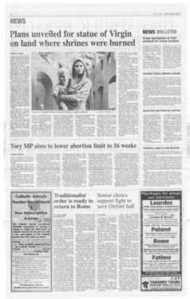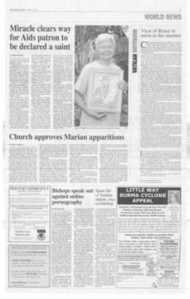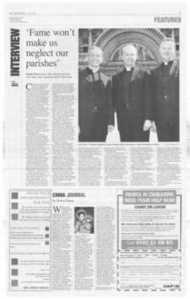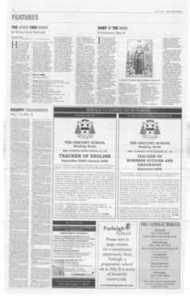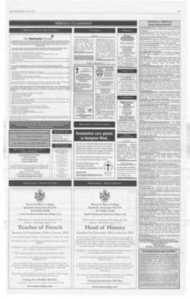Page 5, 9th May 2008
Page 5
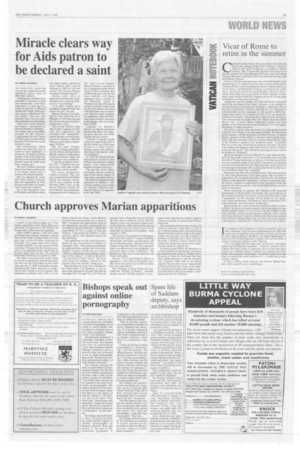
Report an error
Noticed an error on this page?If you've noticed an error in this article please click here to report it.
Tags
Share
Related articles
Us Bishop Approves Marian Apparitions
Dictionary Lists 150 New ‘apparitions’ Of The Virgin Mary
Bishop Orders Seers To End 'apparitions'
French Church Rejects Claims Of Marian Seer
Mel Gibson Plans Film On Disputed Marian Visions
Church approves Marian apparitions
BY DAVID V BARRETT
A SHRINE IN THE FRENCH Alps to a 17thcentury apparition of the Virgin Mary was officially recognised by the Church on Sunday after a three-year investigation.
About 6,000 Catholics, with more than 20 bishops and cardinals, attended a solemn Mass at the shrine to Notre Dame du Laus near Gap, a town 90 miles south-east of Grenoble. The papal nuncio for France, Fortunato Baldelli, was also present for the ceremony. It marked the first formal recognition of an apparition of the Virgin Mary in France since that of the 14-year-old Bernadette Soubirous at Lourdes in 1858.
The shrine was set up in the small village of Ia'is by a shepherdess, Benoite Rencurel. who first saw the Virgin Mary in May 1664 when she was 17. After four months of daily apparitions the Virgin asked her to build a church and a house to receive priests. The apparitions continued until 1718; it is not
known exactly how many visions Benoite received. but some estimates say as many as 600. "I recognise the supernatural origin of the apparitions and facts experienced and recounted by Benoite Rencurel," said Bishop Jean-Michel di Falco Leandri of Gap and Embrun. "1 encourage the faithful to come and pray and to seek spiritual renewal in this sanctuary."
The apparitions in Laus were first investigated by the vicar-general of Embrun in September 1665. After questioning Benoite he celebrated Mass, during which a severely disabled woman claimed she was cured. "There is something extraordinary occurring in that chapel," exclaimed the priest. "Yes, the hand of God is there!" That year work began on building a church for the pilgrims who were already visiting Laus.
Benoite Rencurel. who was a member of the Third Order of St Dominic, is said to have borne stigmata for 20 years. She died on December 28,1718, aged 72.1n 1871 Pius IX declared her a Venerable Servant of God, the first step to sainthood, and in 1893 the church at Laus was declared a minor basilica by Pope Leo MIL However the Vatican has refused requests from local church authorities for Benoite to be beatified most recently in 2003.
The process of recognition of the apparition involved a panel of experts including theologians, historians, psychologists and an investigating judge. The decision of the Vatican means the Church "has committed itself in an official way to say to pilgrims 'you can come here in total confidence— the Bishop of Gap said in an interview on France-Info radio.
He said: "You're not obliged to believe in apparitions, even official recognised ones. But if they are a help in your faith and daily life, why reject them?"
The sanctuary at Notre Dame du Laus, called the "Refuge of Sinners", currently attracts around 120,000 pilgrims a year rather fewer than the five million pilgrims who go to Loonies. in south-western France, each year.
The sanctuary still provides healing oils based on what the Virgin Mary is said to have told the shepherd girl. She told Benoite that oil from the sanctuary lamp in the chapel would cure the sick; over the centuries a number of healings have been reported. Recently a Belgian woman claimed after visiting the shrine that she had been miraculously cured of a slipped disc.
In strictly secular France, the attendance of a senior politician at last Sunday's ceremony has attracted some criticism Hubert Falco, Secretary of State for Territorial Development, said he attended as a private individual and a Catholic, rather than in any official capacity. But even this was an "unacceptable confusion between the values of the republic, including secularism, and religious practices that relate to the private sphere", said a spokesman for the Left Party.
blog comments powered by Disqus



